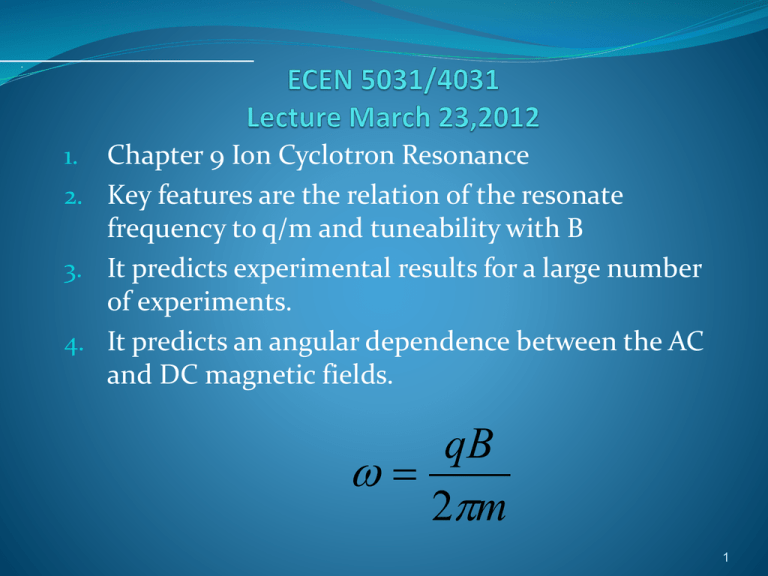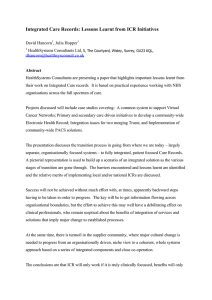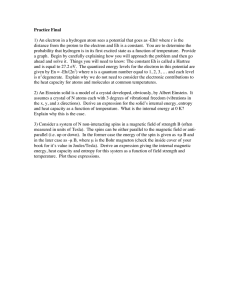Chapter 9 Ion Cyclotron Resonance
advertisement

. Chapter 9 Ion Cyclotron Resonance 2. Key features are the relation of the resonate frequency to q/m and tuneability with B 3. It predicts experimental results for a large number of experiments. 4. It predicts an angular dependence between the AC and DC magnetic fields. 1. qB 2m 1 Ion Cyclotron Resonance Frequencies 2 Ion Cyclotron Resonance Mass of Ion not hydrated. 3 Shape of Curve for Ca++-efflux at 35µT Best fit for ICR to K+ 4 Experimental Data for Ca++-efflux from a chick brain. 5 6 ICR Effects on Cell Culture 7 ICR Effects on Rat Behavior 8 More Data 9 ICR Effects on Diatom Motility 10 ICR Effects on Biological Systems 11 ICR Effects on Plants 12 1 13 Effects on Plants. 14 Orchids 15 Coils for Bone Stimulation 16 Showing both Inhibition and Enhancement of Bone Growth with ICR Exposures 17 Ca Incorporation into Human Lymphocytes 45Ca incorporation (cpm) FIGURE 9.3 Nifedipine concentration ( M) Incorporation of 45Ca in human lymphocytes for unexposed cells (dashed line) and for ICR exposure tuned to the isotopic mass of 45Ca (solid line) after 1 h. In the absence of calcium blocker nifedipine, there is a greater than twofold increase in calcium concentration over controls. The addition of nifedipine completely blocks the calcium uptake resulting from ICR stimulation, providing evidence that the ICR mechanism is related to ion channel transport. (From Rozek, R.J., Sherman, M.L., Liboff, A.R., McLeod, B.R., and Smith, S.D., Nifedipene is an antagonist to cyclotron resonance enhancement of 45Ca incorporation in human lymphocytes, Cell Calcium, 8, 413, 1987.) 18 Problems with ICR 1. The orbit at these B values are meters. 2. How do you isolate the system from noise in the environments and collisions to get the very narrow Δf 3. The masses used do not account for the water molecules that are attached to the ions. 19 An Approach Looking Free Radicals 1. Long lifetimes for Nuclear Magnetic Resonates 2. Coupling between nuclear spins and the electrons in the outer orbits correspond to magnetic fields in the micro-Tesla to milli-Tesla . 3. Changes in orientation of these spins can change the lifetimes for S to T transitions and thus the free radical concentrations. 20 Free Radicals 1 21 More complete Diagram for Transitions between Energy Levels in Magnetic Fields without Hyperfine States. Figure 1 Shows a simplified diagram for the energy levels for a free radical. (Steiner and Ulrich} In the singlet state, S, the spins are aliened in opposite directions or spin up and spin down parallel to the external magnetic field. In the triplet state both spins are aliened or parallel to the magnetic field. 22 Zeeman Splitting for Diatomic Deuterium 23 Energy Level Diagram for NO 24 Low Field Energy Levels for N14 O16 25 Coupling of Energy Level Between States 1. Coupling between electronic energy levels with different angular momentum. RF 2. Hyperfine States , Coupling between Nuclear Energy Levels and the Electron Energy Levels via the B fields Generated by Nuclear Spins with the spins and angular momentum of the electrons, RF 3. Coupling between nuclear spins of adjacent nuclei in the molecule. 4. Coupling between electrons in different orbits. 26 Magnetic Field Dependence of Recombination Rate 27 A Free Radical Concentration vs B 28 Some Radio Frequency Spectra for a Free Radical Pair 29 Changes in Populations Densities with Magnetic Field Amplitude. Changes in Energy Level Population Densities Lead to Changes in Free Radical Concentrations Where neq is the number of free radicals in the initial state, n’eq is the number of free radicals after the field is applied, γ is the gyromagnetic ratio, B1 is the magnitude of the AC magnetic flux density, T1is the relaxation time between states and T2 is the nuclear spin relaxation time (Bovey et al., 1988). 30



